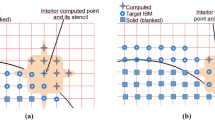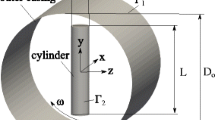Abstract
A dynamic load balancing technique for simulation methods based on hierarchical Cartesian meshes is presented for two applications in this paper. The first method is a hybrid CFD/CAA solver for the prediction of aeroacoustic noise. In this application, a finite-volume method for the large eddy simulation of the turbulent flow field is coupled to a discontinuous Galerkin method for the solution of the acoustic perturbation equations to predict the generation and propagation of the sound field. The second simulation method predicts a combustion process of a premixed fuel. The turbulent flow field is predicted again by large eddy simulation using the finite-volume method, which is coupled to a level-set solver used for the prediction of the flame surface. In both applications, a joint Cartesian mesh is used for the involved solvers, which allows to efficiently redistribute the computational load using a space filling curve. The results show that the dynamic load balancing can enhance the parallel efficiency even for static meshes. The simulation of the combustion process with a solution adaptvie mesh technique demonstrates the necessity of a dynamic load balancing technique.
Access this chapter
Tax calculation will be finalised at checkout
Purchases are for personal use only
Similar content being viewed by others
Notes
- 1.
The geometry of the burner has been provided by EM2C.
References
Ewert, R., Schröder, W.: Acoustic perturbation equations based on flow decomposition via source filtering. J. Comput. Phys. 188(2), 365–398 (2003). http://dx.doi.org/10.1016/S0021-9991(03)00168-2, https://doi.org/10.1016/S0021-9991(03)00168-2
Bridges, J., Brown, C.: Parametric testing of chevrons on single flow hot jets. In: AIAA Paper 2004–2824. http://dx.doi.org/10.2514/6.2004-2824, https://doi.org/10.2514/6.2004-2824
Niemöller, A., Meinke, M., Schröder, W., Albring, T., Gauger, N.: Noise reduction using a Direct-Hybrid CFD/CAA method, Paper 2019-2579. In: AIAA (2019). http://dx.doi.org/10.2514/6.2019-2579, https://doi.org/10.2514/6.2019-2579
Schlottke-Lakemper, M., Yu, H., Berger, S., Meinke, M., Schröder, W.: A fully coupled hybrid computational aeroacoustics method on hierarchical Cartesian meshes. Comput. Fluids 144, 137–153 (2017). http://dx.doi.org/10.1016/j.compfluid.2016.12.001, https://doi.org/10.1016/j.compfluid.2016.12.001
Bailly, C., Juve, D.: Numerical solution of acoustic propagation problems using linearized Euler equations. AIAA J. 38(1), 22–29 (2000). http://dx.doi.org/10.2514/2.949, https://doi.org/10.2514/2.949
Pitsch, H.: A consistent level set formulation for large-eddy simulation of premixed turbulent combustion. Combust. Flame 143(4), 587–598 (2005)
Schlimpert, S., Feldhusen, A., Grimmen, J.H., Roidl, B., Meinke, M., Schröder, W.: Hydrodynamic instability and shear layer effects in turbulent premixed combustion. Phys. Fluids 28(1), 017104 (2016)
Herff, S., Pausch, K., Schlimpert, S., Nawroth, H., Paschereit, C., Schröder, W.: Impact of burner plenum acoustics on the sound emission of a turbulent lean premixed open flame. Int. J. Spray Combust. (2020) (accepted for publication)
Pausch, K., Herff, S., Schröder, W.: Noise sources of an unconfined and a confined swirl burner. J. Sound. Vib. 475(9), 115293 (2020)
Hartmann, D., Meinke, M., Schröder, W.: A strictly conservative Cartesian cut-cell method for compressible viscous flows on adaptive grids. Comp. Meth. Appl. Mech. Eng. 200(9–12), 1038–1052 (2011). http://dx.doi.org/10.1016/j.cma.2010.05.015, https://doi.org/10.1016/j.cma.2010.05.015
Meinke, M., Schröder, W., Krause, E., Rister, T.: A comparison of second and sixth-order methods for large-eddy simulations. Comput. Fluids 31(4–7), 695–718 (2002). http://dx.doi.org/10.1016/S0045-7930(01)00073-1, https://doi.org/10.1016/S0045-7930(01)00073-1
Boris, J.P., Grinstein, F.F., Oran, E.S., Kolbe, R.L.: New insights into large eddy simulation. Fluid Dyn. Res. 10(4–6), 199–228 (1992). http://dx.doi.org/10.1016/0169-5983(92)90023-P, https://doi.org/10.1016/0169-5983(92)90023-P
Schneiders, L., Günther, C., Meinke, M., Schröder, W.: An efficient conservative cut-cell method for rigid bodies interacting with viscous compressible flows. J. Comput. Phys. 311, 62–86 (2016). http://dx.doi.org/10.1016/j.jcp.2016.01.026, https://doi.org/10.1016/j.jcp.2016.01.026
Hartmann, D., Meinke, M., Schröder, W.: An adaptive multilevel multigrid formulation for Cartesian hierarchical grid methods. Comput. Fluids 37(9), 1103–1125 (2008). http://dx.doi.org/10.1016/j.compfluid.2007.06.007, https://doi.org/10.1016/j.compfluid.2007.06.007
Günther, C., Meinke, M., Schröder, W.: A flexible level-set approach for tracking multiple interacting interfaces in embedded boundary methods, Comput. Fluids 102, 182–202 (2014). http://dx.doi.org/10.1016/j.compfluid.2014.06.023, https://doi.org/10.1016/j.compfluid.2014.06.023
Kopriva, D., Woodruff, S., Hussaini, M.: Discontinuous spectral element approximation of Maxwell’s equations. In: Discontinuous Galerkin Methods, Vol. 11 of LNCSE. Springer (2000). http://dx.doi.org/10.1007/978-3-642-59721-3_33, https://doi.org/10.1007/978-3-642-59721-3_33
Kopriva, D.A., Woodruff, S.L., Hussaini, M.: Computation of electromagnetic scattering with a non-conforming discontinuous spectral element method. Int. J. Numer. Meth. Eng. 53(1), 105–222 (2002). http://dx.doi.org/10.1002/nme.394, https://doi.org/10.1002/nme.394
Carpenter, M.H., Kennedy, C.: Fourth-order 2N-storage Runge-Kutta schemes. NASA Report TM 109112, NASA Langley Research Center (1994)
Nourgaliev, R., Theofanous, T.: High-fidelity interface tracking in compressible flows: Unlimited anchored adaptive level set. J. Comput. Phys. 224, 836–866 (2007)
Shu, C.-W., Osher, S.: efficient implementation of essentially non-oscillatory shock capturing schemes. J. Comput. Phys. 77, 439–471 (1988)
Hartmann, D., Meinke, M., Schröder, W.: The constrained reinitialization equation for level set methods. J. Comput. Phys. 229, 1514–1535 (2010)
Lintermann, A., Schlimpert, S., Grimmen, J.H., Günther, C., Meinke, M., Schröder, W.: Massively parallel grid generation on HPC systems. Comp. Meth. Appl. Mech. Eng. 277, 131–153 (2014). http://dx.doi.org/10.1016/j.cma.2014.04.009, https://doi.org/10.1016/j.cma.2014.04.009
Pinar, A., Aykanat, C.: Fast optimal load balancing algorithms for 1D partitioning, J. Parallel Distrib. Comput. 64(8), 974–996 (2004). http://dx.doi.org/10.1016/j.jpdc.2004.05.003, https://doi.org/10.1016/j.jpdc.2004.05.003
Miguet, S., Pierson, J.M.: Heuristics for 1D rectilinear partitioning as a low cost and high quality answer to dynamic load balancing. In: High-Performance Computing and Networking, Vol. 1225 of LNCS, pp. 550–564. Springer (1997). http://dx.doi.org/10.1007/BFb0031628, https://doi.org/10.1007/BFb0031628
Schlottke-Lakemper, , M., Niemöller, A., Meinke, M., Schröder, W.: Efficient parallelization for volume-coupled multiphysics simulations. Comp. Meth. Appl. Mech. Eng. 352 461–487 (2019). http://dx.doi.org/10.1016/j.cma.2019.04.032, https://doi.org/10.1016/j.cma.2019.04.032
Hendrickson, B., Devine, K.: Dynamic load balancing in computational mechanics. Comp. Meth. Appl. Mech. Eng. 184(2–4), 485–500 (2000). http://dx.doi.org/10.1016/S0045-7825(99)00241-8, https://doi.org/10.1016/S0045-7825(99)00241-8
DeRose, L., Homer, B., Johnson, D.: Detecting application load imbalance on high end massively parallel systems. In: Parallel Processing, vol. 4641 of LNCS, pp. 150–159. Springer (2007). http://dx.doi.org/10.1007/978-3-540-74466-5-17, https://doi.org/10.1007/978-3-540-74466-5-17
Böhme, D.: Characterizing Load and Communication Imbalance in Parallel Applications, vol. 23 of IAS, Forschungszentrum Jülich (2014). http://dx.doi.org/10.1109/IPDPSW.2012.321, https://doi.org/10.1109/IPDPSW.2012.321
Teresco, J.D., Devine, K.D., Flaherty, J.E.: Partitioning and dynamic load balancing for the numerical solution of partial differential equations. In: Numerical Solution of Partial Differential Equations on Parallel Computers, vol. 51 of LNCSE, pp. 55–88. Springer (2006). http://dx.doi.org/10.1007/3-540-31619-1-2, https://doi.org/10.1007/3-540-31619-1-2
Hendrickson, B.: Load balancing fictions, falsehoods and fallacies. Appl. Math. Model. 25(2), 99–108 (2000). http://dx.doi.org/10.1016/S0307-904X(00)00042-1, https://doi.org/10.1016/S0307-904X(00)00042-1
Watts, J., Taylor, S.: A practical approach to dynamic load balancing. IEEE Trans. Parallel Distrib. Syst. 9(3), 235–248 (1998). http://dx.doi.org/10.1109/71.674316, https://doi.org/10.1109/71.674316
Jetley, P., Gioachin, F., Mendes, C., Kalé, L., Quinn, T.: Massively parallel cosmological simulations with ChaNGa. In: IPDPS, pp. 1–12. IEEE (2008). http://dx.doi.org/10.1109/IPDPS.2008.4536319, https://doi.org/10.1109/IPDPS.2008.4536319
Dongarra, J., et al.: The international exascale software project roadmap. Int. J. High Perform. Comput. Appl. 25(1), 3–60 (2011). http://dx.doi.org/10.1177/1094342010391989, https://doi.org/10.1177/1094342010391989
Menon, H., Jain, N., Zheng, G., Kalé, L.: Automated load balancing invocation based on application characteristics. in: Cluster Comput. 373–381. IEEE (2012). http://dx.doi.org/10.1109/CLUSTER.2012.61, https://doi.org/10.1109/CLUSTER.2012.61
Anderson, E., Bai, Z., Bischof, C., Blackford, S., Demmel, J., Dongarra, J., Du Croz, J., Greenbaum, A., Hammarling, S., McKenney, A., Sorensen, D.: LAPACK Users’ Guide, 3rd edn. SIAM (1999)
Tanna, H.K.: An experimental study of jet noise Part I: Turbulent mixing noise. J. Sound Vibr. 50(3), 405–428 (1977). http://dx.doi.org/10.1016/0022-460X(77)90493-X, https://doi.org/10.1016/0022-460X(77)90493-X
Pauz, V., Niemöller, A., Meinke, M., Schröder, W.: Numerical analysis of chevron nozzle noise. In: AIAA Paper 2017–3853. http://dx.doi.org/10.2514/6.2017-3853, https://doi.org/10.2514/6.2017-3853
Moeck, J.P., Bourgouin, J.-F., Durox, D., Schuller, T., Candel, S.: Nonlinear interaction between a processing vortex core and acoustic oscillations in a turbulent swirling flame. Combust. Flame 159(8), 2650–2668 (2012)
Gupta, A., Lilley, D., Syred, N.: Swirl Flows. Abacus Press, Tunbridge Wells, England (1984)
Poinsot, T., Lele, S.K.: Boundary conditions for direct simulations of compressible viscous flows. J. Comput. Phys. 101(1), 104–129 (1992)
Rudy, D.H., Strikwerda, J.C.: A nonreflecting outflow boundary condition for subsonic Navier-stokes calculations. J. Comput. Phys. 36, 55–70 (1980)
Acknowledgements
This study was funded by the Deutsche Forschungsgemeinschaft (DFG, German Research Foundation), DFG project number 335858412 and 247310774. The authors gratefully acknowledge the Gauss Centre for Supercomputing (GCS) for providing computing time for a GCS Large-Scale Project on the GCS share of the supercomputer “Hazel Hen” at HLRS Stuttgart. GCS is the alliance of the three national supercomputing centres HLRS (Universität Stuttgart), JSC (Forschungszentrum Jülich), and LRZ (Bayerische Akademie der Wissenschaften), funded by the German Federal Ministry of Education and Research (BMBF) and the German State Ministries for Research of Baden-Württemberg (MWK), Bayern (StMWFK), and Nordrhein-Westfalen (MIWF).
Author information
Authors and Affiliations
Corresponding author
Editor information
Editors and Affiliations
Rights and permissions
Copyright information
© 2021 The Author(s), under exclusive license to Springer Nature Switzerland AG
About this paper
Cite this paper
Meinke, M., Niemöller, A., Herff, S., Schröder, W. (2021). Dynamic Load Balancing for Coupled Simulation Methods. In: Resch, M.M., Wossough, M., Bez, W., Focht, E., Kobayashi, H. (eds) Sustained Simulation Performance 2019 and 2020. Springer, Cham. https://doi.org/10.1007/978-3-030-68049-7_5
Download citation
DOI: https://doi.org/10.1007/978-3-030-68049-7_5
Published:
Publisher Name: Springer, Cham
Print ISBN: 978-3-030-68048-0
Online ISBN: 978-3-030-68049-7
eBook Packages: Mathematics and StatisticsMathematics and Statistics (R0)




